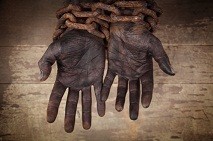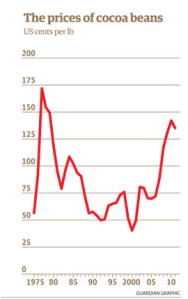Hundreds of thousands of children work on cocoa farms to produce chocolate consumed around the world.
Marsha van der Krabben & Thomas Hauschildt I Originally published in Think Africa Press

Slavery: New concept, but still present. Source: Soulcare
For many, Christmas is upon us once again. And like every other year chocolate will be sold in vast quantities. But unbeknownst to most consumers, some of the chocolate they buy will have partly been the product of slavery and child labour in West Africa.
A bittersweet product
West Africa was responsible for nearly three quarters of the 4.24 million tonnes cocoa beans produced worldwide last year – the Ivory Coast alone produced roughly 1.5 million tonnes, or one third of the world’s production, while Ghana produced over 1 million tonnes. According to some research, these two countries also rely on around 1.8 million child labourers.
Regarding the Ivory Coast, some have claimed that 90% of cocoa farms use child labour, while the US Department of State estimates that over 100,000 children work under “the worst forms of child labour” on Ivorian farms. Around 15,000 children are thought to be forced to work as slaves in the Ivory Coast, and 10,000 are believed to be victims of human trafficking, largely from neighbouring Mali and Burkina Faso.
But this is not just an Ivorian or even a West African issue. The global scope of the problem becomes apparent when one considers that it is not just West African governments and farmers who are involved in the trade chain, but also chocolate manufacturers, supermarkets and finally consumers.
 All the countries mentioned have signed the 1989 UN Convention on the Rights of the Child which holds that children have inalienable rights, and obligates states to promote, guarantee and respect the rights of children against violence, exploitation and hazardous work or work that interferes with their education. But the practical application of the convention is a challenge as many cocoa farms are located in remote areas and are difficult for the authorities to access.
All the countries mentioned have signed the 1989 UN Convention on the Rights of the Child which holds that children have inalienable rights, and obligates states to promote, guarantee and respect the rights of children against violence, exploitation and hazardous work or work that interferes with their education. But the practical application of the convention is a challenge as many cocoa farms are located in remote areas and are difficult for the authorities to access.
Furthermore, underlying some farmers’ decisions to replace paid labour with unpaid forced child labour are economic factors such as unstable cocoa bean prices. Moreover, children are sometimes sent away by their own parents in the expectation that they will not only be able to provide financial support for their families, but also acquire practical skills valuable for a future career.
Pushing the issue
The problem of child labour on Ivorian cocoa farms is thus a multi-faceted problem and requires action from a variety of actors at different levels.
One initiative to raise public awareness of child labour and slavery in cocoa farming came from Dutch journalist Teun van de Keuken, who in 2008 handed himself into police and attempted to prosecute himself for being an accomplice to slavery by being a chocolate consumer.
The court threw out the case but did declare: “To put an end to slavery practices, the accountability lies with the industry, governments and of course the consumer, you and me”. Van de Keuken subsequently set up a chocolate brand that guarantees slave-free chocolate production: Tony’s Chocolonely.
There have also been efforts from government to tackle the issue. In 2001, US politicians Tom Harkin and Eliot Engel set up a protocol to develop a certification system for chocolate products. Engel and Harkin proposed a law that would require chocolate to labelled “child-labour-free” to assure consumers of how their cocoa goods were produced and pressure chocolate companies into tackling the issue. There was resistance from the industry and a compromise was reached whereby companies could voluntarily certify they had stopped using child labour. A decade later, many of the provisions of the protocol have still not been met.

Child labour and cocoa farms – a widespread issue in West Africa. Source: Forbes
In another initiative earlier this year, the European Parliament passed the Resolution on Child Labour in the Cocoa Sector which calls upon governments, global industry, cocoa producers, organised labour, NGOs and consumers to live up to their responsibilities in working towards a sustainable cocoa supply chain free from child labour. The real repercussions of the agreements remain to be seen.
The role of industry
There has also been some action by the chocolate industry itself.
European chocolate producers are organised in the Association of Chocolate, Biscuit and Confectionary Industries of the European Union (CAOBISCO) which represents over 2,000 European companies. Additionally, the European Cocoa Association (ECA) is intended to consolidate the industry by, for example, conducting research in order to improve the quantity and quality of cocoa production.

Cocoa trade: Global trade, local suffering. Source: Guardian
Both of these organisations can and should play a pivotal role in combating child labour. CAOBISCO can appeal to its members to focus on ethical cocoa trade and ECA’s research could lead to improvements in agricultural production which, in turn, could generate higher profits for cocoa farmers and decrease the need for unpaid child labour.
Both CAOBICO and ECA welcomed the new European Parliament Resolution and stated that they are working on improving the traceability of the cocoa supply chain and accountability in production practises. However, ECA admits that the problem of slavery is not easy to solve due to the remote location of cocoa farms and widespread poverty. Furthermore, the trade chain is difficult to monitor due to the involvement of several traders.
A global problem
Over the years, there has been a growing recognition that child labour is a serious and systemic problem in cocoa production. The governments of cocoa producing nations along with chocolate companies cannot ignore this, and increasingly neither can the governments of importing nations and their consumers – all of these parties are, after all, implicated in global networks and exchanges that perpetuate slavery, trafficking and child labour.
Responsibility spreads far and wide, and a holistic approach involving the government, farmers, chocolate producers, supermarkets and consumers is needed in order to establish tangible results.

Is there any data around child labor by nations to support it? Its really dark side of the chocolate world. If people knew the fact around it, it will shock lot of people.